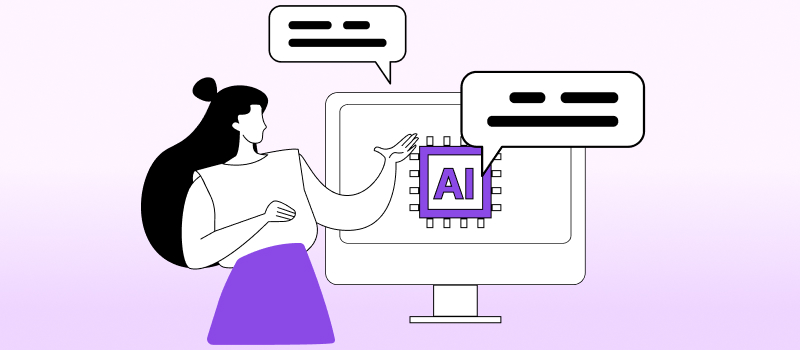
In the world of business, there is a growing phenomenon that’s causing havoc in the workplace – quiet quitting. Now, before you start picturing employees sneaking out of the back door without saying a word, let us explain.
Quiet quitting is the act of disengaging from work without actually quitting your job. Yep, it’s like quitting, but not really quitting. Confusing, right?
And yet, this subtle form of disengagement is far more common than you might imagine and is silently undermining the productivity and morale of organizations across industries.
So, what’s causing this trend and how can we combat it? Join us as we delve into the complexities of quiet quitting and explore practical strategies to re-engage and retain talent.
Get ready to tackle this pervasive challenge head-on!
What Is Quiet Quitting?
To put it simply, quiet quitting is the act of just doing the bare minimum to meet expectations. It’s like hitting cruise control on your productivity and never daring to step on the accelerator.
Employees who are quietly quitting may fulfill their basic responsibilities, but they no longer put in the extra effort that they once did (if ever). They’re no longer interested in going above and beyond and look to do only what is necessary to get by.
7 Key Characteristics of Quiet Quitting
- Meeting expectations but not exceeding them: Quiet quitters focus on completing their assigned tasks and meeting deadlines, but they don’t volunteer for extra work or take on additional initiatives.
- Disengaging from work-related activities outside of work hours: Quiet quitters avoid checking emails or taking work calls outside of their designated work hours. They prioritize personal time and establish clear boundaries between work and life.
- Adopting a “work to live, not live to work” mentality: Quiet quitters view their jobs as a means to an end, not as their primary identity or source of fulfillment. They focus on their personal lives and interests outside of work.
- Lacking enthusiasm about work: While not every day on the job will be sunshine and roses, a consistently negative attitude towards assignments and projects, coupled with a failure to offer constructive feedback or suggest solutions, is a sign that an employee may be checked out mentally.
- Not speaking up during meetings (unless prompted by a direct address): Disengaged employees will often keep their ideas to themselves and opt to remain in the background, choosing not to draw attention to themselves.
- Withdrawing from social interactions with colleagues: Quiet quitters tend to isolate themselves from other team members, avoid corporate events and happy hours, or fail to engage in collaborative efforts.
- Having a lot of unplanned absences: If an employee is taking extra-long lunch breaks, calling in sick more often than usual, or showing up late without explanation, it suggests a lack of interest in being present and engaged at work.
Origins of the Quiet Quitting Trend
The origins of the term “quiet quitting” can be traced back to a March 2022 TikTok video posted by Brian Creely, a Gen-X career coach and employment influencer. In the video, Creely discussed an Insider article about employees “coasting” at work and coined the phrase “quiet quitting” to capture this phenomenon.
The term quickly gained traction on social media, sparking debate about whether it was a new trend or simply a rebranding of an existing issue. Some argued that quiet quitting was a symptom of burnout and work-life imbalance, while others criticized it as a form of laziness or disengagement.
Despite the controversies, there is no doubt that quiet quitting is a growing issue in the workplace. A Gallup poll found that only 32% of U.S. workers were engaged in their jobs in 2022 (down from 36% in 2020).
This decline in engagement is likely due to a number of factors, including the aftermath of the COVID-19 pandemic, the rise of the gig economy, and the increasing demands of modern workplaces. And while the origins of quiet quitting may be complex, its effects are clear: it is a symptom of much deeper problems in the workplace – and they mostly result from poor management decisions.
Top Reasons Behind Quiet Quitting
If you’re seeing your employees losing their spark and settling into a state of mediocrity, that’s probably because they have problems with work engagement. And while personal reasons – like the lack of intrinsic motivation or changing interests and priorities in employees’ lives – may be at the root of it all, in many cases, quiet quitting is a direct result of your management approach:
- Lack of recognition and growth opportunities: Imagine working tirelessly day in and day out without ever receiving even a simple pat on the back or a sign of appreciation – that’s enough to make anyone just give up. After all, what’s the point of putting in extra effort if you’re not going to be acknowledged for it or given a chance to progress?
- Unrealistic expectations and toxic work culture: If you set unrealistic expectations, micromanage employees, or foster a culture of fear and intimidation, you create an environment where your team feels disrespected and unsupported. This often leads to resentment and a desire to withdraw from work.
- Poor communication: When employees feel like they’re not being heard or that their concerns are being brushed aside, they may start to lose motivation and interest in interacting with colleagues or contributing to the shared cause.
- Inadequate compensation: If employees feel like they’re not fairly compensated for their performance or that their financial needs aren’t met, they may simply disengage from their current role or begin searching for a better-paying job.
- Boredom and the lack of meaningful work: Disengagement is a natural outcome when you’re lacking a sense of purpose or significance at work. When you don’t see the impact of your contributions, don’t feel connected to the company’s mission, and perform repetitive, boring tasks every day, your motivation plummets very quickly.
- Burnout and work-life imbalance: Balancing work and personal life can be a struggle, and when the scales tip too far in one direction, burnout can rear its ugly head. Employees may start to detach themselves from their work and become less invested in it. It’s like watching a balloon slowly deflate until it’s just a sad, limp version of its former self.

Use actiTIME to manage employee workloads and track work progress with ease.
Is Quiet Quitting That Bad?
Employee perspective
When managers ask for extra effort without giving you anything in return, and you don’t have an opportunity to actually leave the company for now, quiet quitting is all that’s left to avoid burnout and preserve your mental and physical well-being.
That’s fair.
The problem arises only if you seek to advance in your career. High achievements and ambitious professional goals don’t align that well with doing the bare minimum and staying in the background all the time. So, you need to take a thorough look at your career prospects at the current workplace and be willing to either collaborate with your employer to get to the place where you wanna be professionally or change your job for a more promising one if your needs are constantly not met.
Employer perspective
For employers, quiet quitting equals a lost opportunity to improve productivity, drive innovation, and attain truly excellent performance results.
Even if quiet quitters on your team complete all the assigned tasks relatively well, their lack of motivation, enthusiasm, and creative spark are sure to slow down your progress and definitely won’t help you conceive unique ideas, produce new outstanding products, or render exceptional customer service.
However, the situation may get much worse if quiet quitters frequently go absent. In that case, about 8.7% of all your payroll costs will be associated with staff absenteeism – and that’s a hefty sum, especially if your team is large enough and quiet quitting is widespread.
So, what can you do to avoid that?
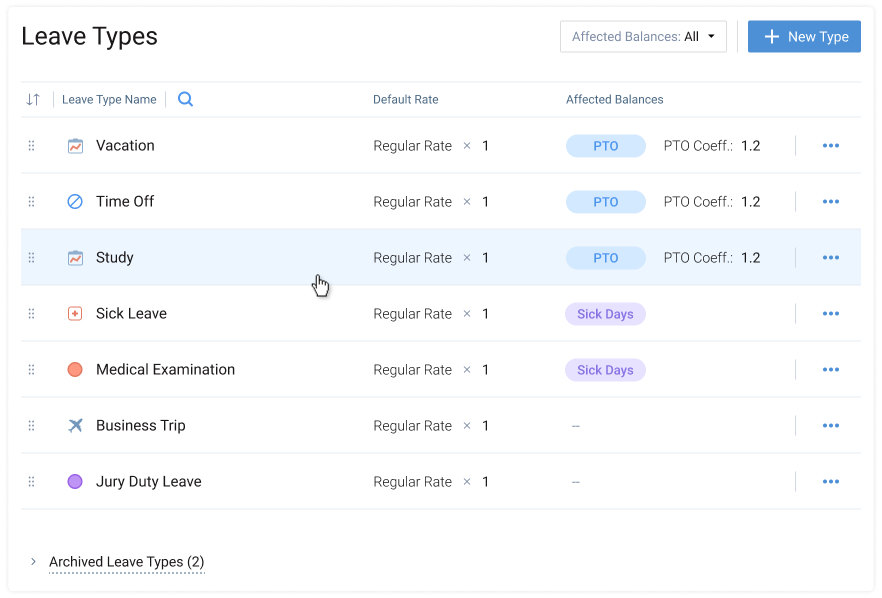
Create and track different types of leave in your actiTIME account to stay in control of staff absences at all times.
How to Prevent Quiet Quitting in Your Team
1. Hire the right employees
Bringing on employees with the right level of motivation can make all the difference in the success of your company as they will be more likely to strive for excellence in their work.
Whereas quiet quitters may see meeting the bare minimum as enough, intrinsically motivated employees will push themselves to go above and beyond. These are the types of employees who will take pride in their work and be motivated to constantly improve.
But it’s not just about the quality of work. Happy and engaged employees are also more likely to stick around, reducing turnover and saving you both time and money in the long run. By hiring the right people, you’ll create a positive workplace culture that can take your entire team from mediocre to magnificent.
Tips:
To identify the right employees, look for candidates who demonstrate a strong work ethic and passion for their field:
- Seek out those who have gone above and beyond in previous roles or taken on challenging projects of their own accord.
- Don’t be afraid to ask probing questions during the hiring process to gauge motivation and drive.
- Be sure to contact references to get a sense of the candidate’s work ethic.
2. Eliminate unnecessary workload
When employees are bogged down with tasks that don’t align with their job descriptions or are simply repetitive and mundane, their productivity and morale tend to take a dip.
Furthermore, a heavy workload can lead to burnout and high levels of stress, which not only affect the employees’ mental and physical health but also decrease their ability to produce quality work. This, in turn, can negatively impact the organization’s reputation and bottom line.
Tips:
- Identify the core tasks that are absolutely essential for the team to succeed: What are the primary drivers of the team’s output and success? Which tasks, if not completed, would result in immediate negative consequences? Start by prioritizing those and focus on the must-do tasks.
- Eliminate unnecessary meetings: We’ve all experienced meetings that could have been emails. Or worse, meetings that could have been avoided altogether. Review and analyze the number, type, and frequency of meetings scheduled, and eliminate those that are not essential. Instead of utilizing traditional business meetings, employ agile stand-up meetings to ensure everyone is on the same page without eating into valuable working hours.
- Put technology to work: With a project management solution like actiTIME, you can reduce unnecessary manual tasks and increase team efficiency. This software automates a bunch of repetitive processes (including cost tracking and leave management) and helps to manage the entire scope of work in a truly convenient way. With actiTIME, you can allocate work to employees and set task priorities in a few simple clicks and then track the ongoing performance progress in multiple formats: the Kanban board, weekly timesheets, comprehensive reports, and more.
Create a custom workflow in your actiTIME account to track ongoing progress and workloads without a hitch.
3. Give employees diverse and challenging tasks
To reduce the risk of quiet quitting, make sure your team members don’t yawn their way through mundane, repetitive tasks. Instead, keep employees engaged and encouraged to reach their full potential – give them diverse and challenging enough tasks that will keep them on their toes and drive productivity through the roof.
Tips:
- Understand your employees’ skills and interests: Assigning tasks that cater to their strengths and passions will not only keep them engaged but also produce better results. Don’t make the mistake of assigning tasks solely based on job title or seniority.
- Mix it up and introduce new projects that require different skill sets: This will not only challenge your employees but also allow them to learn new things and keep things interesting. After all, variety is the spice of work life!
- Set clear expectations and guidelines for each task: Ensure your employees fully understand what is expected of them, the timelines, and the desired outcomes. Avoid micromanagement but provide resources and support to help them succeed.
4. Set individual performance goals
Sometimes, all that quiet quitters need is a sense of purpose and direction. Without a clear understanding of their roles and responsibilities, they may feel lost and uncertain about how their work fits into the larger scheme of things. Setting individual performance goals can help to mitigate this issue and ensure everyone is working towards a common goal.
Furthermore, individual performance goals provide a way to track progress and measure success. By setting specific targets and milestones, you can easily monitor your employees’ work results and identify areas where they might need extra support or guidance.
Tips:
- Align individual goals with company objectives: Ensure that each employee’s goals are aligned with the overall goals and objectives of the company. This creates a sense of purpose and connection for employees, making them feel that their work directly contributes to the success of the organization.
- Involve employees in the goal-setting process: This fosters a sense of ownership and commitment to achieving the goals. Collaboratively discuss individual strengths, areas for development, and aspirations to set goals that are both challenging and realistic.
- Use the SMART method: The SMART method is a framework for setting effective goals that are Specific (i.e., clearly defined and unambiguous), Measurable (i.e., with quantifiable targets to track progress), Achievable (i.e., challenging but attainable within the given timeframe), Relevant (i.e., they align with the employee’s role, skills, and the company’s objectives), Time-Bound (i.e., they have a defined deadline to create a sense of urgency and focus).
- Provide regular feedback and check-ins: Schedule regular check-ins with employees to discuss progress, address challenges, and provide feedback. This ongoing communication helps keep employees motivated and on track toward achieving their goals.
- Recognize and reward accomplishments: Celebrate successes and acknowledge employee achievements. Recognition and rewards reinforce positive behavior and motivate employees to continue striving for excellence.
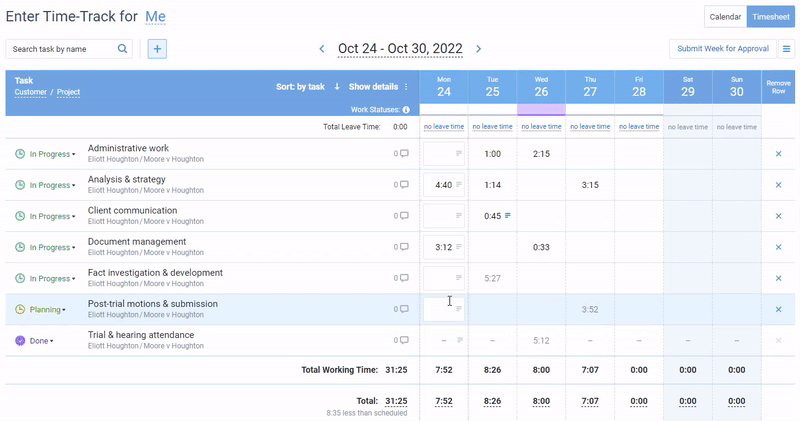
Use actiTIME to track and measure employees’ performance and never miss an opportunity to praise their success.
5. Improve your workplace culture
A workplace culture that helps to get rid of quiet quitting for good is one that values open communication, fosters collaboration, provides employees with all the support they need and promotes a sense of purpose and meaning. This type of culture inspires employees to bring their best selves to work, cultivate a positive attitude, and actively engage in problem-solving and innovation.
Tips:
- Foster a sense of purpose and belonging: Help employees understand how their work contributes to the company’s mission and values. Encourage teamwork, collaboration, and social connections among employees to create a sense of community.
- Reward achievements: Regularly acknowledge and celebrate employee accomplishments, both big and small. Offer meaningful rewards, such as bonuses, promotions, or non-monetary incentives, to reinforce positive behavior.
- Provide opportunities for growth and development: Invest in employee training and development programs to help them acquire new skills and advance their careers. Encourage mentorship and peer learning to foster a culture of continuous learning.
- Empower employees and encourage feedback: Give employees a voice in decision-making processes and encourage them to provide feedback on workplace issues. Create a safe space for open communication and address concerns promptly.
- Promote a culture of transparency and trust: Be open and transparent with employees about company decisions, challenges, and successes. Build trust by following through on commitments and demonstrating integrity in leadership.
- Offer competitive compensation and benefits: Provide employees with fair compensation and benefits packages that reflect their value and contributions to the company. Stay informed about industry trends and benchmarks to ensure your offerings remain competitive.
- Encourage a healthy work environment: Prioritize employee well-being by promoting healthy habits, offering ergonomic workspaces, and providing access to mental health resources.
- Promote work-life balance: Encourage employees to take breaks, utilize their paid time off, and disconnect from work after hours. Respect their personal boundaries and avoid creating a culture of overwork.
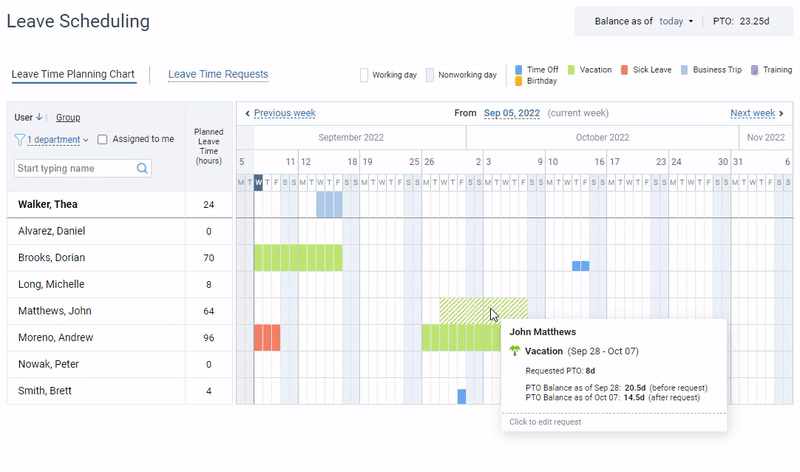
Provide employees with enough vacation time and track it with ease using actiPLANS.
6. Identify quiet quitters early on
Data analytics can play a crucial role in preventing quiet quitting by providing insights into employee behavior, engagement levels, and potential risk factors. By analyzing various data sources, you can identify patterns and trends that may indicate a growing prevalence of quiet quitting and take proactive measures to address underlying issues.
Tips:
- Carry out employee engagement surveys: These surveys gather direct feedback from employees about their work experiences, satisfaction levels, and perceptions of the workplace. They can reveal underlying issues that may contribute to quiet quitting, such as feelings of burnout or overwork, perceived lack of opportunities for growth, etc. After analyzing survey responses, you can create targeted interventions to improve employee engagement and address underlying concerns.
- Analyze staff absence trends: Increased absenteeism, particularly unexplained absences or extended sick leave, may be a sign of disengagement and a lack of motivation to come to work. So, consider adopting a leave management solution like actiPLANS to monitor staff absence patterns over time and identify individuals who may be exhibiting quiet quitting tendencies.
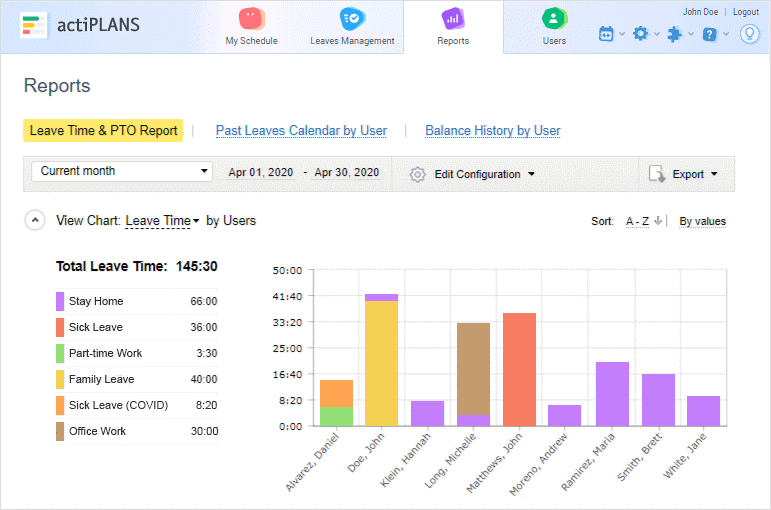
actiPLANS reports allow you to analyze team absence trends, and easily detect consistent patterns of unexplained absences or sudden increases in absenteeism among employees.
Conclusion
To sum up, quiet quitting is a real thing. It disrupts workplace morale and hinders team productivity.
To deal with the problem effectively, it’s important for companies to recognize the signs of disengagement in employees and take preventative steps:
- Create a positive workplace culture,
- Manage workloads properly,
- Support employees in professional growth,
- Help them develop a sense of purpose at work,
- Set individual performance goals, etc.
On top of that, to make sure you promote the best performance within your team, try actiTIME – it provides employees with convenient tools to track their time and tasks, which creates a sense of accountability and ensures that everyone knows what they are responsible for.
Furthermore, actiTIME allows managers to easily monitor their team’s progress and make adjustments where necessary. This means that any issues can be addressed quickly, without escalating into bigger issues.
So don’t wait – sign up for a free trial now.
















































